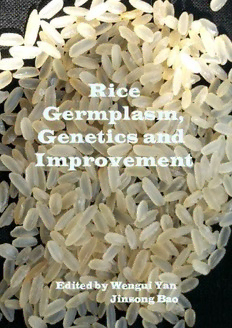
Rice - Germplasm, Genetics and Improvement PDF
Preview Rice - Germplasm, Genetics and Improvement
Rice Germplasm, Genetics and Improvement Edited by Wengui Yan and Jinsong Bao Rice: Germplasm, Genetics and Improvement Edited by Wengui Yan and Jinsong Bao D3pZ4i & bhgvld, Dennixxx & rosea (for softarchive) Stole src from http://avaxho.me/blogs/exLib/ Published by AvE4EvA Copyright © 2014 All chapters are Open Access distributed under the Creative Commons Attribution 3.0 license, which allows users to download, copy and build upon published articles even for commercial purposes, as long as the author and publisher are properly credited, which ensures maximum dissemination and a wider impact of our publications. After this work has been published by InTech, authors have the right to republish it, in whole or part, in any publication of which they are the author, and to make other personal use of the work. Any republication, referencing or personal use of the work must explicitly identify the original source. As for readers, this license allows users to download, copy and build upon published chapters even for commercial purposes, as long as the author and publisher are properly credited, which ensures maximum dissemination and a wider impact of our publications. Notice Statements and opinions expressed in the chapters are these of the individual contributors and not necessarily those of the editors or publisher. No responsibility is accepted for the accuracy of information contained in the published chapters. The publisher assumes no responsibility for any damage or injury to persons or property arising out of the use of any materials, instructions, methods or ideas contained in the book. Publishing Process Manager Technical Editor AvE4EvA MuViMix Records Cover Designer Published 23 April, 2014 ISBN-10 9535112406 ISBN-13 978-9535112402 C ontents Preface 1 Unraveling the Secrets of Rice Wild Species 2 Genes and QTLs Resistant to Biotic and Abiotic Stresses from Wild Rice and Their Applications in Cultivar Improvements 3 Rice Germplas m in Korea and Association Mapping 4 Association Mapping of Four Important Traits Using the USDA Rice Mini-Core Collection 5 Identification and Utilization of Elite Genes from Elite Germplasms for Yield Improvement 6 Functional Characterization of Genes/QTLs for Increasing Rice Yield Potential 7 Current Advances on Genetic Resistance to Rice Blast Disease 8 Rice Straighthead Disease - Prevention, Germplasm, Gene Mapping and DNA Markers for Breeding 9 Genes and QTLs for Rice Grain Quality Improvement 10 Chinese Experiences in Breeding Three-Line, Two-Line and Super Hybrid Rice VI Contents Preface Rice is a staple food for half of the worlds population mostly in Asia. Productivity of rice has largely been improved since the Green Revolution in 1960s. Further improvement of rice yield is necessary to keep pace with population growth, which is a challenging task for breeders. This book, Rice: Germplasm, Genetics and Improvement, as its name implies, comprehensively reviews current knowledge in germplasm exploration, genetic basis of complex traits, and molecular breeding strategies in rice. In the germplasm part, we highlight the application of wild rice in rice breeding. In the genetics part, most of the complex traits related with yield, disease, quality have been covered. In the improvement part, Chinese experiences in hybrid rice breeding have been summarized together with many molecular breeding practices scattering in different chapters. Chapter 1 Unraveling the Secrets of Rice Wild Species Ehsan Shakiba and Georgia C. Eizenga Additional information is available at the end of the chapter http://dx.doi.org/10.5772/58393 1. Introduction The world is facing a new challenge with global population predicted to plateau at nine billion people by the middle of this century (Godfray et al. 2010). Increasing food production to feed the world’s population is an even greater challenge considering that agriculture is experiencing greater competition for land, water and energy, as well as, the effects of substantial climate change and the unintended effects of crop production on the environment. Part of the solution to increasing food production on the same or less cultivated land lies in exploiting the subset of genes lost during the domestication process and subsequent targeted breeding. Currently, these valuable genes are found only in the progenitor species genepool for crop cultivars. Cultivated plants having desirable genes were utilized in intensive breeding projects focused on increasing yield for particular environments and management systems but this process has narrowed the genetic diversity (Rausher 2001). For cultivated plants, this unexploited genetic material includes both landraces and the more exotic wild relatives. Improving our under‐ standing of this tertiary gene pool and exploiting it for crop improvement is paramount to meeting the challenges of feeding the world in this century through the integration of classical genetics and genomics-enabled research paradigms. The loss of genetic diversity can be more problematic for self-pollinated plant species where the rate of cross pollination is below five percent, thus making it more difficult to reintroduce the lost diversity. In the case of the two major grain crops, rice (Oryza sativa L.) and wheat (Triticum aestivum L.), both self-pollinated, the re-introduction genetic diversity from the wild is central to the continued success of breeding, given that viruses, fungi, and bacteria, three main causal agents of biotic stress, are constantly evolving to cause the breakdown of the host plant’s defense mechanisms (Rausher 2001). Abiotic stress, including salinity, aluminum toxicity and acid sulfate soils, as well as, temper‐ ature and drought, complicate the difficulty of improving crop yields, especially in the face of
